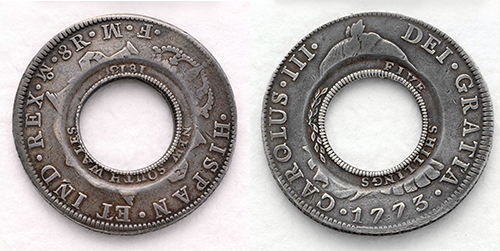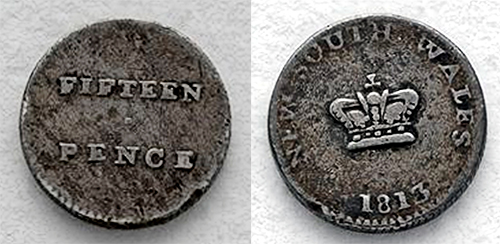Home > Stories by TimeLine Auctions
Stories by TimeLine Auctions
From Pieces Of Eight .. to Pieces of Two
Collectors from countries across the world know and admire the Spanish silver 8 reales as a handsome numismatic piece. Its accuracy of weight, purity of silver, and milled edge as a safeguard against clipping, also gave the denomination an international reputation. In the 18th and early 19th centuries reales were the currency of world trade. During those years the silver eight reales was known, throughout all English-speaking colonies, and in post-Colonial America, as the Spanish Dollar. (See TimeLine Auctions archived catalogues for several examples we have auctioned in the past.) From 1732 – 1826 the eight reales was minted using a coin press; but in earlier centuries its silver blanks were hand-cut from bars of silver, then struck by hand-hammering between two dies to produce the famous pieces of eight, renowned in tales of piracy, captured Spanish ships, and seized cargoes of coins and bullion. Even after the introduction of the machine-made round coin, its older name was often still applied to the Spanish eight reales.

In 1796 Britain’s war against Republican France had brought three attempts to deploy French troops in Ireland and in Wales. As a result, British government expenditure on supplies and pay for militia regiments had increased. In the same year, English counties had to cope with poor weather, reduced grain harvests, and high bread prices. We must then factor-in the huge costs of fighting France and her allies on the Continent and overseas. A money crisis loomed in London, with customers clamouring at the doors of the Bank of England to change banknotes for gold and silver coins. Out of character, British Treasury officials acted with alacrity. They instructed the Bank of England to dip into its silver reserves (total £241,000 in Spanish dollars) and to countermark each coin with a small head of George III stamped into the neck of the Charles III image on the obverse; then to issue the duly stamped coins as English 5s pieces. The practice continued well into the next century in efforts to reduce backlogs of work at the Royal Mint ..
Nine years later, in April 1805, at Warwick Assizes, a cutler and metal plater named William Henshall was found guilty of forging Bank of England dollars. Had the law run its prescribed course he would certainly have suffered execution. But Henshall, a talented craftsman, offered to name other forgers; and to reveal to the appropriate authorities ways of combatting the crime. In exchange he asked for a sentence of Transportation; and that his wife and family be permitted to accompany him to New South Wales. A bargain was struck.

Established in 1788, New South Wales ran a barter economy during its first century as a penal settlement, relying for loose change on whatever coins arrived in sailors’ pockets; and on rum as its unofficial currency. The economy had strengthened a little by 1812 when Governor Lachlan Macquarie received from London a consignment of 40,000 assorted Spanish dollars of various monarchs and dates, with instructions to prevent the new money from leaving the colony. William Henshall’s penal sentence had only months to run by that date; but the Governor, who had learned of his skills at metal working, ordered Henshall brought to Government House where Macquarie persuaded him, with offers of earlier release, to help set up equipment for countermarking the newly arrived coins, and probably to cut them into pie-shaped segments to serve as lower denominations. It may have been Henshall who came up with the suggestion to remove a centre plug (later known as the dump) for use as a 1s 3d coin, and to denominate the larger doughnut-shaped pieces as 5 shillings. An advantage to this method of dividing the dollars came from reducing opportunities to clip silver from exposed coin edges.

It took an entire year for Henshall to design the necessary equipment; to re-strikeeach dump with NEW SOUTH WALES 1813 around an obverse crown; and with FIFTEEN PENCE on its reverse; thento engrave the dies to countermark New South Wales 1813 around the obverse hole; and Five Shillings around the reverse hole. With the work completed, the converted Spanish dollars went into circulation in 1814 as the colony’s first official coinage. Records show that the emancipated William Henshall did not leave Australia until 1817. His later history is unknown.
Sterling coinage gradually replaced the holey dollar, and the British government demonetized it in 1829. In succeeding years lost or hoarded holey dollars have come to light; perhaps the most notable (found in a Tasmanian hoard in 1826) had countermarked a Spanish dollar carrying a portrait of King Joseph of Spain, older brother of Napoleon Bonaparte. The coin sold at auction in 2018 for A$500,000.
Brett Hammond (Chief Executive Officer), TimeLine Auctions, 11th May 2023




